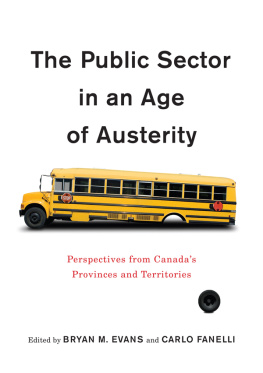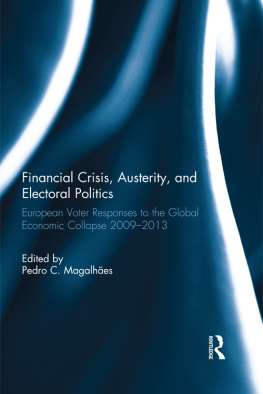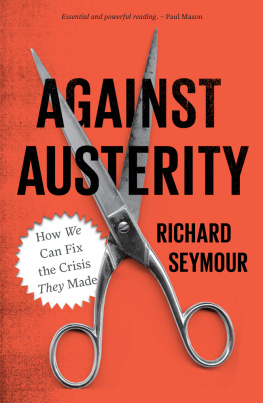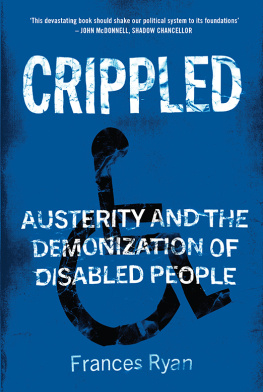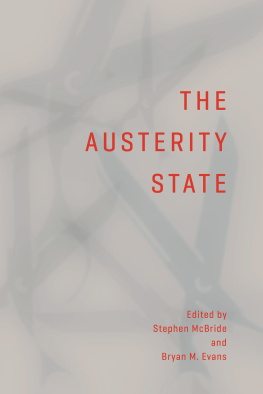THE PUBLIC SECTOR IN AN AGE OF AUSTERITY
The Public Sector in an Age of Austerity
Perspectives from Canadas Provinces and Territories
Edited by
BRYAN EVANS AND CARLO FANELLI

McGill-Queens University Press 2018
ISBN 978-0-7735-5334-7 (cloth)
ISBN 978-0-7735-5335-4 (paper)
ISBN 978-0-7735-5418-4 (ePDF)
ISBN 978-0-7735-5419-1 (ePUB)
Legal deposit second quarter 2018
Bibliothque nationale du Qubec
Printed in Canada on acid-free paper that is 100% ancient forest free (100% post-consumer recycled), processed chlorine free
This book has been published with the help of a grant from the Canadian Federation for the Humanities and Social Sciences, through the Awards to Scholarly Publications Program, using funds provided by the Social Sciences and Humanities Research Council of Canada. Funding was also received from the Office of the Dean of Arts, Ryerson University.

We acknowledge the support of the Canada Council for the Arts, which last year invested $153 million to bring the arts to Canadians throughout the country.
Nous remercions le Conseil des arts du Canada de son soutien. Lan dernier, le Conseil a investi 153 millions de dollars pour mettre de lart dans la vie des Canadiennes et des Canadiens de tout le pays.
Library and Archives Canada Cataloguing in Publication
The public sector in an age of austerity: perspectives from Canadas provinces and territories/edited by Bryan Evans and Carlo Fanelli.
Includes bibliographical references and index.
Issued in print and electronic formats.
ISBN 978-0-7735-5334-7 (cloth) ISBN 978-0-7735-5335-4 (paper) ISBN 978-0-7735-5418-4 (ePDF) ISBN 978-0-7735-5419-1 (ePUB)
1. Finance, Public Canada Provinces. 2. Fiscal policy Canada Provinces. 3. Civil service Canada Provinces. 4. Neoliberalism Canada Provinces. 5. Global Financial Crisis, 20082009 Government policy Canada Provinces. 6. Canada Appropriations and expenditures, Provincial. I. Evans, Bryan M., 1960, editor II. Fanelli, Carlo, 1984, editor
JL198.P83 2018 | 336.01371 | C2018-901384-2 |
C2018-901385-0 |
This book was typeset by Marquis Interscript.
Tables and Figures
TABLES
1.1Goods-producing sector as a share of provincial GDP, select Canadian provinces (200713)
1.2BC provincial budgets
1.3Unemployment rate
1.4Employment rate
2.1Provincial revenues and expenditures 200715
2.2Oil and gas revenues in dollars and as a percentage of overall revenues and number of civil servants
9.1PEI selected labour market statistics, 200415
9.2PEI labour market statistics for public service and health sectors, 19952014
9.3Comparison of home care and hospital share of provincial government health expenditures, Maritime provinces and Canada, current dollars
9.4Comparison of provincial government per capita home care expenditures, Maritime provinces and Canada, 199091, 199899, 200304, constant dollars
10.1Titles of the Newfoundland and Labrador provincial budgets, 200214
10.2Key content words and context, 2004, 2008, and 2013
10.3Reducing the progressive nature of the income tax regime in Newfoundland, 200511
10.4Deteriorating provincial economic indicators
11.1Nunavut fiscal and economic indicators
13.1Major federal transfers to Yukon, dollars
13.2General economic indicators
13.3Yukon GDP and select industries, millions of chained (2007) dollars
13.4Yukon budget, thousands of dollars
13.5Yukon revenues
13.6Public-sector negotiated wage increases
FIGURES
2.1Alberta population over time: 19712016
3.1Saskatchewan unemployment, 19872015
3.2Saskatchewan GDP growth, 19812014
3.3Saskatchewan gross domestic product, 200715
3.4Goods-producing and service-producing values, 200715
4.1Manitoba core government revenues and expenditures, 200813
6.1Debt and deficits
6.2Quebecs tax expenditures
6.3Quebecs revenues from PIT and consumption taxes
6.4Quebecs operating expenses and inflation
7.1Province of New Brunswick, net debt
7.2Province of New Brunswick annual surpluses and deficits
8.1Major fiscal events in Nova Scotia
9.1Major health and fiscal policy events in PEI
10.1Newfoundland and Labrador provincial revenues, 200115
10.2Taxable incomes by income category in 2005 and 2011
10.3Number of people in each income category in 2005 and 2011 and the proportional change
10.4Per capita distribution in 2010 of the tax cuts of 2007, 2008, and 2010
10.5Budget speech: Two hundred most commonly used content words in the provincial budgets, 200414
11.1Crude rate of death by suicide by Nunavut Inuit and all Canadians, 19722015
12.1Total federal support to NWT by fiscal year, millions of dollars
12.2NWT territorial population estimates
12.3NWT territorial population estimate percentage change
12.4NWT mineral exploration and deposit appraisal expenditures, millions of dollars
12.5NWT mineral production, dollar value
12.6NWT per capita allocation, dollars
12.7NWT territorial revenue, millions of dollars
12.8NWT territorial expenditures, millions of dollars
12.9NWT capital expenditures, millions of dollars
12.10NWT public employment (survey of all employment, payrolls, and hours all levels, annual average, in dollars)
12.11NWT unemployment rate
12.12NWT not-in-labour force, thousands of people
12.13NWT territorial surplus/deficit, millions of dollars
THE PUBLIC SECTOR IN AN AGE OF AUSTERITY
INTRODUCTION
The Permanent Unequal Union: Canadas Provinces and Territories in an Era of Neoliberalism
BRYAN EVANS AND CARLO FANELLI
The decades following the end of the Second World War witnessed the high-water mark in the construction of the Canadian welfare state. As the chapters that follow make clear, the provinces often through federal cost-sharing arrangements led this transformation in the public economy. The resulting expansion in public goods and services saw total provincial government spending rise from 6.4% of gross national product (GNP) in 1955 to 16% in 1974 (Stevenson 1989, 80). Canadas postwar federalism reflected a path of policy innovation and province building that emerged from an economy characterized by deep regionalization and the increasingly ambitious provincial states with responsibility over key accumulation policy domains such as natural resources, labour, transportation, and education. A significant fiscal policy role can be added to this mix. Obviously, other important policy areas not necessarily tied to accumulation strategies fell, in whole or in part, under provincial jurisdiction owing to the makeup of the Canadian constitution. For instance, the provinces and initially excluding but slowly expanding to largely include the territories were granted responsibility for social welfare, health care, and education, as well as jurisdiction over natural resources and employment standards legislation. On the other hand, the federal government oversaw concerns related to the national interest, equal treatment and opportunity, equalization payments, international trade (which brought resources under federal jurisdiction), and Indigenous concerns.
The three decades following the Second World War were formative to the creation of the Canadian version of the golden age of Keynesian-inspired capitalism. That paradigm began to unravel in the 1970s as the accumulation of capital stumbled and entered into a prolonged period of transformation. The provinces in particular, given the policy and program areas for which they were responsible, would by necessity become critical sites of struggle and contestation over the rolling out of what would eventually come to be called neoliberalism. At a basic theoretical level, neoliberalism can be understood as a policy framework characterized by strong private property rights, free trade, and unfettered markets backed by a state that creates and preserves the institutional arrangements conducive to such practices. The federal structure of Canada, together with the highly regional differentiation of the provinces political economies, meant that this process would be uneven and fragmented.

